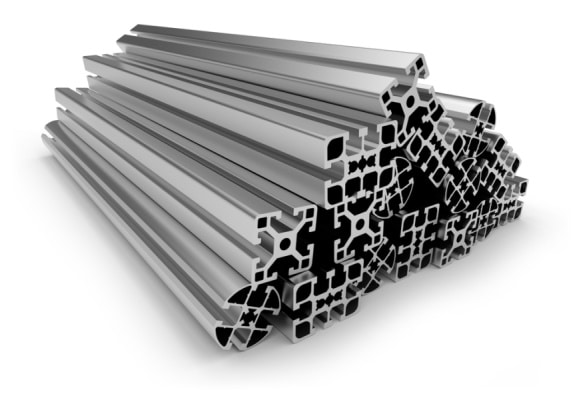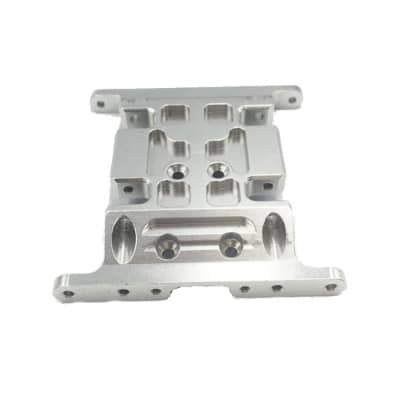Aluminum Extrusion Services
Get quality custom parts for prototyping and production, fast and cost-effective.
Aluminum Extrusion Materials
| Aluminum | |||||||
| 3003 | 5053 | 6063 | |||||
| 5052 | 6061 | 7075 | |||||
Aluminum Extrusion Finishes
Standard. With no secondary processing.
Anodizing is an electrochemical process that converts the metal surface into a decorative, durable, corrosion-resistant, anodic oxide finish.
Aluminum is ideally suited to anodizing, although other nonferrous metals, such as magnesium and titanium, also can be anodized.
The bead blasting process shoots a blasting media – beads – under high pressure at a part to clean, polish, or roughen it to the desired finish.
A bead blast finish can clean a part’s surface, remove cosmetic defects, create a uniform surface with a dull, satin, or rough texture, and even harden a part’s surface and enhance its durability. It also prepares a part for paint and other coatings.
Bead media includes steel, glass, quartz sand, garnet, etc.
Manufacturers apply bead blasting for materials like metals, plastics, rubber, and glass.
Electrophoresis is the process of applying paint to parts by passing an electric current through the paint solution and parts immersed in it.
In many ways, this process is similar to electroplating. It is also called electrocoating, e-coating, electrophoretic coating, and electrophoretic painting.
Electrophoresis is suitable for aluminum alloy, zinc alloy, and stainless steel. It makes the parts present various colors and keep the metallic luster, and enhances the surface performance with high corrosion resistance.
Electroplating is the process of applying a thin layer of one metal to a part by passing a positively charged electrical current through a solution containing dissolved metal ions (anode) and a negatively charged electrical current through the part to be plated (cathode).
The aim is to improve the overall quality of the part. Some benefits include improving corrosion resistance, wear resistance, appearance, lubricity, and solderability.
Steels, nickel, copper-based alloys, and other metals are readily electroplated.
Polishing is the process of creating a shiny and smooth surface, either through physical rubbing of the part or by chemical interference.
The process enhances the aesthetic appeal, prevents corrosion, improves cleanability, and reduces adhesion of the parts.
It produces a surface with significant specular reflection but can reduce diffuse reflection in some materials.
Polishing works excellent with many metals, including aluminum, brass, stainless steel, and steel.
Powder coating is a process of applying a free-flowing, dry, thermoset, or thermoplastic powder to the surface of a part which is then cured under heat or with ultraviolet light.
The process creates a strong, wear- and corrosion-resistant layer that is more durable than standard painting methods.
It works perfectly on metals, plastics, and other materials.
Don’t see the finish you need? Please submit a RFQ, and we will look into a finishing process for you.
Aluminum Extrusion Capabilities
| Metric | Imperial | |
| Max. Part Size | Ø1000 x 1500 mm | Ø393.70 x 590.55 in |
| Tolerance | ±0.025 mm | ±0.001 in |
Tolerances: Metals will be +/- 0.005″ (+/- 0.127 mm?) in accordance with ISO 2768 unless otherwise specified. Plastics and composites will be +/- 0.010”.
What is Aluminum Extrusion?
Aluminum extrusion is the manufacturing process in which aluminum is forced through a die under high pressure to produce continuous linear profiles with a constant cross-section.
Advantages of Aluminum Extrusion
Suited for producing parts with complex cross-sections
High mechanical properties are achievable by cold extrusion
Lower tooling costs than die casting or injection molding

Aluminum Extrusion FAQs
Aluminum extrusion is a metal forming process used to transform lengths of aluminum alloy into objects with a cross-section. The aluminum lengths, called billets, are pushed through an extrusion die with a smaller cross-sectional area than the billets. The formed lengths, called profiles, can be used in various applications.
The aluminum extrusion process is relatively quick, simple, and cost-effective, and aluminum is particularly suited to this forming.
There is no set cost to a die. It depends on the customizations, including size, shape, and finishing.
No, we are a custom aluminum extrusion supplier. We work with trusted aluminum extrusion manufacturers to offer custom aluminum extrusion services for prototyping and low-volume production.
We can offer extrusion fabrication and finishing solutions, ranging from CNC machining to assembly, to produce final parts faster and more affordably.
6000 series aluminum extrusion alloys are widely available and suited to most commercial applications due to their mechanical properties, diverse finishing options, and high flexibility.
They are lightweight, resistant to corrosion, well suited to fabrication such as welding, and have high thermal and electrical conductivity.
How It Works
Get your parts with an easy 6-step process
Submit Your Inquiries
Get a Quote with Free DFM
Place an Order
Review Samples
Kickoff Production
Recieve Your Parts
Ready to Get Your Project Started?
Try our manufacturing services. We are committed to helping you fulfill your projects, from prototyping to production.
